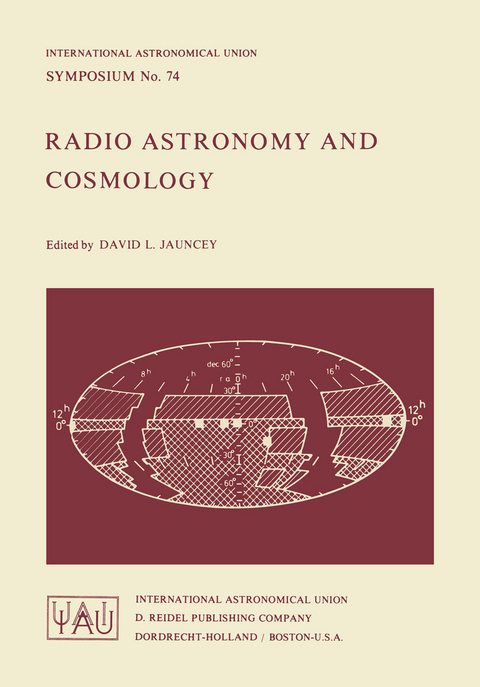
Radio Astronomy and Cosmology
Kluwer Academic Publishers (Verlag)
978-90-277-0839-7 (ISBN)
337 F(e) = (z) where the angle between the directions III and 112 is equal to 8. r is the angular diameter effective distance of the epoch for recombination. F (8) ~ve have F(e) : f (e) ~ (S" ) e. . ~ is a Bessel function. It is assumed here that the spectrum of gravitational waves takes the form 1/ hI'::: hoK for all relevant wavelengths, a is beam width of the radio antenna, d/= d~, and ~ is the duration of the process of recombinations in /-time. The results for different beam widths are shown in Fig. 1. 338 I. D. NOVIKOV 1-. . . -__ 0. 5 1 1. 5 2 e' 0. 5 o and for a l' (solid line) and Fig. 1. The function f(8) for n for a = 2' (dotted line). These formula should be used in analysing the implications of future observations. Comparison with the observational data now available enables us to establish an upper limit for the energy density of long gravitational waves. This method is most sensitive for gravitational waves with A ~ ct The fluctuations ~; due to these waves have scale ~ 0. 03 GW rec 4 radian. If, according to modern observations, we take ~; < 10- , then 8 26 ~GW/Ey < 10- for those gravitational waves which have A = 5. 10 cm GW today where Ey is the energy density of relict radiation. The fluctuations ~TT due to long gravitational waves with A = ct .
I. Surveys of Radio Sources, Source Counts and Anisotropies.- The 6C Survey.- Survey of Data for Determining Scales of the Absolute Flux Densities in 10–180 MHz Range and Source Spectra in the Declination Strip 10°–20° (Not presented at Symposium).- Interim Report on the Texas Survey.- The Bologna Survey of Radio Sources at 408 MHz.- The Molonglo Radio Source Surveys at 408 MHz.- Westerbork Surveys of Radio Sources at 610 and 1415 MHz.- The Green Bank Surveys at 1400 MHz.- The Parkes 2700 MHz Survey: Counts of the Sources and their Distribution on the Sky.- Surveys of Radio Sources at 5 GHz.- The Statistical Analysis of Anisotropics.- II. Spectral Index Distributions.- Spectra of Southern Radio Sources.- Spectral Index Studies of Extragalactic Radio Sources.- III. Angular Diameter-Redshift and Flux Density Tests.- Radio Source Angular Sizes and Cosmology.- The Angular Size — Flux Density Relation.- The Flux Density — Angular Size Distribution for Extragalactic Radio Sources.- The Angular Diameter-Redshift Test for Large Redshift Quasars.- The Angular Diameter-Redshift Relation for Scintillating Radio Sources.- IV. Optical Spectra and Identifications.- The Present Status of 3CR Identifications.- QSO Identifications from a Molonglo Radio Survey.- Identifications from the WSRT Deep Surveys.- Luminosity Functions for Extragalactic Radio Sources.- Physical Conditions in Radio Galaxies and Quasars.- Absorption Systems in High Redshift QSO’s.- Relations between the Optical and Radio Properties of Extragalactic Radio Sources.- Relations between Radio and Optical Properties of Radio Sources — Radio Astronomer’s Point of View.- V. Interpretation of Cosmological Information on Radio Sources.- Interpretation of Cosmological Information on Radio Sources.-Cosmological Interpretation of Redshift Data on Quasars through the V/Vmax Test.- Interpretation of Source Counts and Redshift Data in Evolutionary Universes.- The Redshift-Magnitude Relation for Radio Galaxies.- The Hubble Diagrams for Quasars.- Clusters of Galaxies and Radio Sources.- VI. Microwave Background Radiation.- Microwave Background Spectrum — Survey of Recent Results.- Small Scale Fluctuations in the Microwave Background Radiation Associated with the Formation of Galaxies.- Fluctuations in the Microwave Background Caused by Anisotropy of the Universe and Gravitational Waves.- VII. More Interpretation of Cosmological Information on Radio Sources.- The Physics of Radio Sources and Cosmology.- Young Galaxies, Quasars and the Cosmological Evolution of Extragalactic Radio Sources.- Polarization Measurements of Distant Sources.- Rotation Measures and Cosmology.- Cosmological Information from New Types of Radio Observations.- Progress, Problems and Priorities: A Personal View.- Appendix: The Complete Sample of 166 3CR Sources.
| Erscheint lt. Verlag | 30.9.1977 |
|---|---|
| Reihe/Serie | International Astronomical Union Symposia ; 74 |
| Zusatzinfo | 6 Illustrations, black and white; 416 p. 6 illus. |
| Verlagsort | Dordrecht |
| Sprache | englisch |
| Maße | 170 x 244 mm |
| Themenwelt | Naturwissenschaften ► Physik / Astronomie ► Astronomie / Astrophysik |
| Naturwissenschaften ► Physik / Astronomie ► Relativitätstheorie | |
| Naturwissenschaften ► Physik / Astronomie ► Theoretische Physik | |
| ISBN-10 | 90-277-0839-8 / 9027708398 |
| ISBN-13 | 978-90-277-0839-7 / 9789027708397 |
| Zustand | Neuware |
| Haben Sie eine Frage zum Produkt? |
aus dem Bereich


